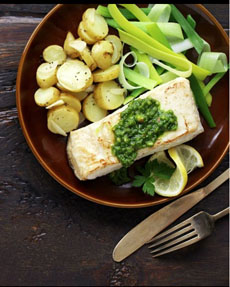TIP OF THE DAY: Buying Fresh Fish
|
Are you cooking fish less often because you’re not comfortable with your technique? There are plenty of videos online that show you just how easy it is to cook fish: on the stovetop, in the oven, on the grill. The key is this: don’t overcook it. Fish is far more delicious on the rare side than well done. (Sushi lovers can vouch that it’s wonderful absolutely raw.) Today’s tip mostly focuses on buying the best fish. For advice, we turned to the experts at Arch Rock Fish restaurant in Santa Barbara. Chef Scott Leibfried has also provided a simple and delicious recipe. Tomorrow, we’ll present Chef Scott’s cooking tips Arch Rock Fish has the benefit of the local Santa Barbara Fish Market, which the chef visits each morning to search for the freshest catches of the day. But even if you’re limited to a supermarket fish department, you can use the look, smell and touch tests to get the best fish available. Good chefs buy fish based on these criteria. So you may have salmon in mind, but if it looks a little tired, go for a fresher variety. A good portion size is six to seven ounces. |
Check the eyes for clear, not cloudy, lenses. Photo of red snapper courtesy KleerIceSupplies.com.au. |
|
|
BUYING WHOLE FISH Examine the whole fish for freshness: |
||
 Simply prepared halibut with Yukon Gold potatoes and leeks. Photo courtesy PaperChef.com. |
BUYING FISH FILLETS
SELECTING CRABS & LOBSTERS In the market for lobster or crab? Look for specimens that are moving around and look lively. The motionless ones are likely no longer eating, and this self-starvation yields less meat. |
|
|
EASY FISH RECIPE WITH LEMON & PESTO Ingredients For 4 Servings 1. CLEAN, cut and portion fish, for beginners I definitely recommend a halibut fillet not a whole halibut and skin off is better for this dish 2. RUB oil on the halibut, season with salt and pepper and placce in a baking dish that’s been wiped with oil. Depending on your oven (everyone’s varies!) and the thickness of the fish, bake at 375°F for 15 minutes. Always check the doneness: A cooked fish shouldn’t be translucent; the flesh should be firm and beginning to flake when touched with a fork. While the fish is cooking… 3. MAKE the pesto. Zest the lemons and combine with garlic, basil, parsley, pistachios salt and pepper in a food processor. Pulse until minced. With the motor running, slowly stream in olive oil until the sauce forms. 4. SERVE by placing pesto atop the cooked fish. Garnish with a lemon wheel. If you feel more ambitious, consider Chef Scott’s preferred garnish: “I personally like to fry a leaf of basil, until it becomes like a clear green chip.” 5. SERVE with a starch—orzo, a bed of pasta, potatoes, rice—and greens. |
||



